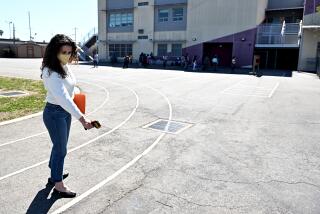L.A. Schools Adopt $3.9-Billion Budget : Education: It is called leanest since passage of Proposition 13. But more cuts are possible.
The Los Angeles school board approved its $3.96-billion, 1990-91 budget Monday, completing its most difficult round of fiscal deliberations since Proposition 13 slashed school revenues in 1978.
“It’s the leanest budget since Proposition 13 and one of the most uncertain budgets since Proposition 13” because of continuing state funding disputes, said Henry Jones, director of budget services for the 610,000-student Los Angeles Unified School District.
Because of employee pay increases and low balances carried over from last year--coupled with reductions in state funding--the district found itself $220 million in the hole before budget discussions began this year.
The board made those cuts, including almost $60 million from its administrative offices and another $80 million in services that will directly affect students, then found itself facing the likelihood that up to $77 million in additional cuts will be needed later in the school year.
“With things still changing in Sacramento . . . I think, undoubtably, we will be into this budget again,” board President Jackie Goldberg said before the vote.
The budget--approved 6 to 1, with Rita Walters dissenting because she objected to the nature of the cuts--is essentially the same as the tentative plan approved in June. It allocates almost $3 billion, 75% of its total, to employee salaries and benefits. Last year, teachers were granted 8% annual pay raises to settle a strike. The board then gave most other employees the same hike. District revenues during that time failed to keep pace with increases.
Funding cuts by Gov. George Deukmejian may cost the district another $77 million. In July, Deukmejian reduced from 4.76% to 3% the schools’ annual cost-of-living funding increase, costing the Los Angeles district $40 million. He also held up funding for several district programs--including $26 million for year-round schools, $5 million for the new medical magnet high school, and $3.4 million for drivers’ education.
State Controller Gray Davis said he intends to defy Deukmejian and pay schools at the 4.76% level, in anticipation of a legislative compromise restoring the full amount.
“Davis’ action . . . allows us to assume that’s the law right now and the money is flowing,” said Jones, admitting that the district could be in dire financial straits if funding is reduced to the 3% level.
“Technically, we have a balanced budget now,” agreed district finance chief Robert Booker, “but if the (cost of living allocation) is not increased by the Legislature by the end of the year, we will have to make additional budget adjustments.”
The earlier cuts included 269 layoffs, the elimination of another 731 positions by attrition, thousands of forced unpaid leaves and cuts in custodial services.
The district has faced a series of financial blows in addition to Deukmejian’s cuts, including a newly enacted $8.5-million annual assessment by the county for the collection of property taxes, and an expected $15-million reduction in money received from state lottery proceeds. Those cuts may require the district to redistribute some of its budgeted funds during the school year, Booker said.
More to Read
Sign up for Essential California
The most important California stories and recommendations in your inbox every morning.
You may occasionally receive promotional content from the Los Angeles Times.










